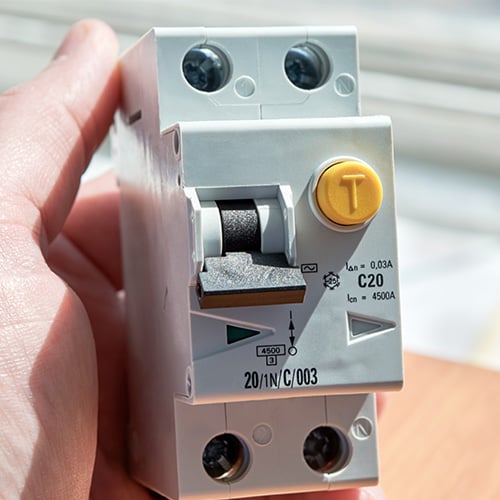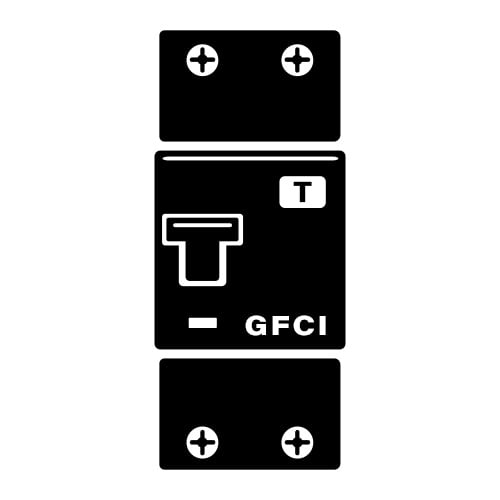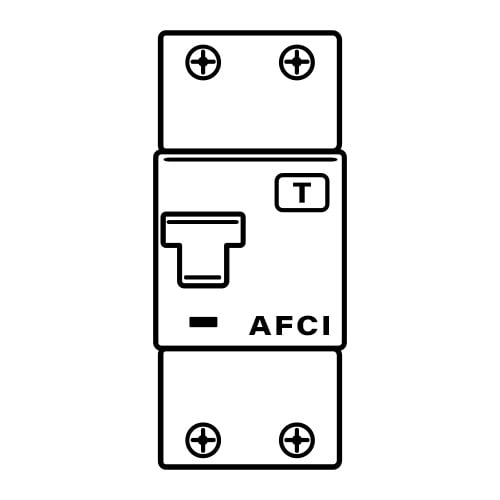
Circuit breakers protect your business from electrical hazards, but what are they and how do they work? While you should always leave the installation and maintenance of circuit breakers to the professionals, you don't need to be a certified electrician to understand the basics. We’ll explain why circuit breakers are so important and identify the differences between types of breakers.
What Is a Circuit Breaker?

A circuit breaker is a safety device that regulates the current running through an electrical circuit. If the current becomes too strong, the circuit breaker automatically switches off and interrupts the current. This prevents a hazardous electrical current from causing damage to equipment, igniting an electrical fire, or causing electric shock.
How Do Circuit Breakers Work?
Circuit breakers contain delicate sensors that detect when the amperage of an electric current is too high to be supported by the circuit. Sometimes a current builds up over time until it becomes too strong for the circuit, which is called an overload. A sharp rise in current that occurs very quickly is called an overcurrent. When an electrical overload or overcurrent occurs, the circuit breaker automatically shuts off and disrupts the current. You’ll hear this referred to as a “tripped circuit”.
An overload or overcurrent impact can cause damage very quickly. Without circuit breakers, the circuit wiring would overheat, the insulation would melt, and an electrical fire could start. Electrical equipment could also be damaged. This makes circuit breakers an essential fire safety device for any building, including restaurants, hotels, and other small businesses.
Circuit Breaker Types

Now that you know the main function of a circuit breaker, let’s explore the three main types of circuit breakers and how they are used.
1. Standard Circuit Breakers
Standard circuit breakers are mostly used in homes or small businesses that operate on 120V/240V single-phase electric power. If you aren’t familiar with electrical terms, this is a standard electrical wiring configuration that supports lights and outlets at 120V and larger appliances at 240V.
There are two types of standard circuit breakers:
- Single Pole - Single pole breakers protect one energized wire and supply 120V to a circuit. These are the most common types of breakers in homes, but they are also used in small businesses.
- Double Pole - Double pole breakers protect two wires at the same time and occupy two slots in a breaker panel. These types of breakers supply 120V/240V or 240V to large appliances. The breaker will trip if either wire becomes overloaded.
2. GFCI Circuit Breakers

Ground fault circuit interrupters (GFCI) are a type of breaker that disconnects a circuit if the electrical current is traveling on an unwanted path and there is a risk of electrocution. In technical terms, this is called a line-to-ground fault. A ground fault happens when the electrical path of the current comes into contact with a conductor, which could be any item that conducts electricity, like metal pipes, metal components on equipment, or even water. It’s called a ground fault because electrical currents always travel to the ground. If an unintentional pathway has been created by a conductor, the electricity will take the quickest path to the ground, even if that means traveling through a human body.
GFCI circuit breakers are required in many businesses to prevent electrocution, especially in areas like kitchens and bathrooms where water comes into close contact with electrical equipment. If a line-to-ground fault is formed, the GFCI circuit breaker will sense the unwanted path and disconnect the circuit.
To help you remember the purpose of a GFCI circuit breaker, review these highlights:
- GFCI stands for Ground Fault Circuit Interrupter
- GFCI breakers are used in wet or damp environments
- The main purpose of a GFCI is to protect against electrocution
3. AFCI Circuit Breakers

Arc fault circuit interrupters (AFCI) are a type of circuit breaker that disconnects when an electrical arc is detected. An electrical arc occurs when a current running through a wire jumps to another path. This could happen if an electrical wire is damaged or faulty and the current “jumps” to another location. Arcs like this produce a lot of heat and have the potential to ignite nearby materials.
AFCI breakers are not required in businesses unless the business contains a "dwelling unit". This includes hotels, resorts, campgrounds, vacation rentals, and any hospitality business that provides lodging.
- AFCI stands for Arc Fault Circuit Interrupter
- AFCI breakers are required in hotels, guest rentals, and resorts
- The main purpose of an AFCI is to protect against electrical fires
AFCI vs GFCI
The main difference between these two types of breakers is that AFCI breakers protect against electrical fires and GFCI breakers protect against electrocution. AFCI and GCI breakers look very similar and the best way to tell them apart is to look for an identification label on the front of the breaker.
What Is a CAFCI Circuit Breaker?
CAFCI stands for Combination Arc Fault Circuit Interrupter. This type of circuit breaker protects against both arc faults and ground faults.
Circuit Breaker FAQ

We answer common questions about circuit breakers below:
What Is a Short Circuit?
A short circuit occurs when an energized wire comes into contact with a neutral wire and the electric current jumps between the two wires. A common cause of short circuits is when the insulation that protects the wires becomes worn and the bare wires touch each other. This can cause sparks and potentially ignite a fire. Circuit breakers are designed to detect a short circuit and disconnect the current.
Ground Fault vs Short Circuit
A ground fault and short circuit are similar because they both happen when an electric current takes an unwanted pathway. In a short circuit, the pathway is usually between an energized wire and a neutral wire. A ground fault occurs when the current passes from an energized wire to a grounded conductor like the metal frame of a breaker box. Both occurrences are detected by a circuit breaker.
Circuit Breaker vs Surge Protector
Surge protectors are electrical safety devices with a different function than circuit breakers. While circuit breakers protect electrical wires from too much amperage, surge protectors protect electrical equipment from a voltage spike. Lightning strikes are a common cause of voltage spikes or power surges.
Fuse Box vs Circuit Breaker

You may hear breaker panels referred to as fuse boxes, but they are actually two different devices. Fuse boxes are an old-style electrical safety device that relies on fuses to regulate the electric current in a circuit. You may have heard the expression "blow a fuse". This occurs when the circuit becomes overloaded with current and the fuse melts, disrupting the current. A blown or melted fuse has to be replaced. Circuit breakers, however, don't need to be replaced every time they become tripped. They have switches that can be powered back on once the source of the electrical issue has been identified and resolved.
What Is the NEC?
NEC is a safety acronym that stands for the National Electric Code. Part of the National Fire Code, the NEC dictates a set of standards for the safe installation and maintenance of electrical wiring and equipment.
It's best to leave the installation and maintenance of circuit breakers to certified electricians, but it helps to understand why tripped circuits occur and what the potential hazards are for your business.





